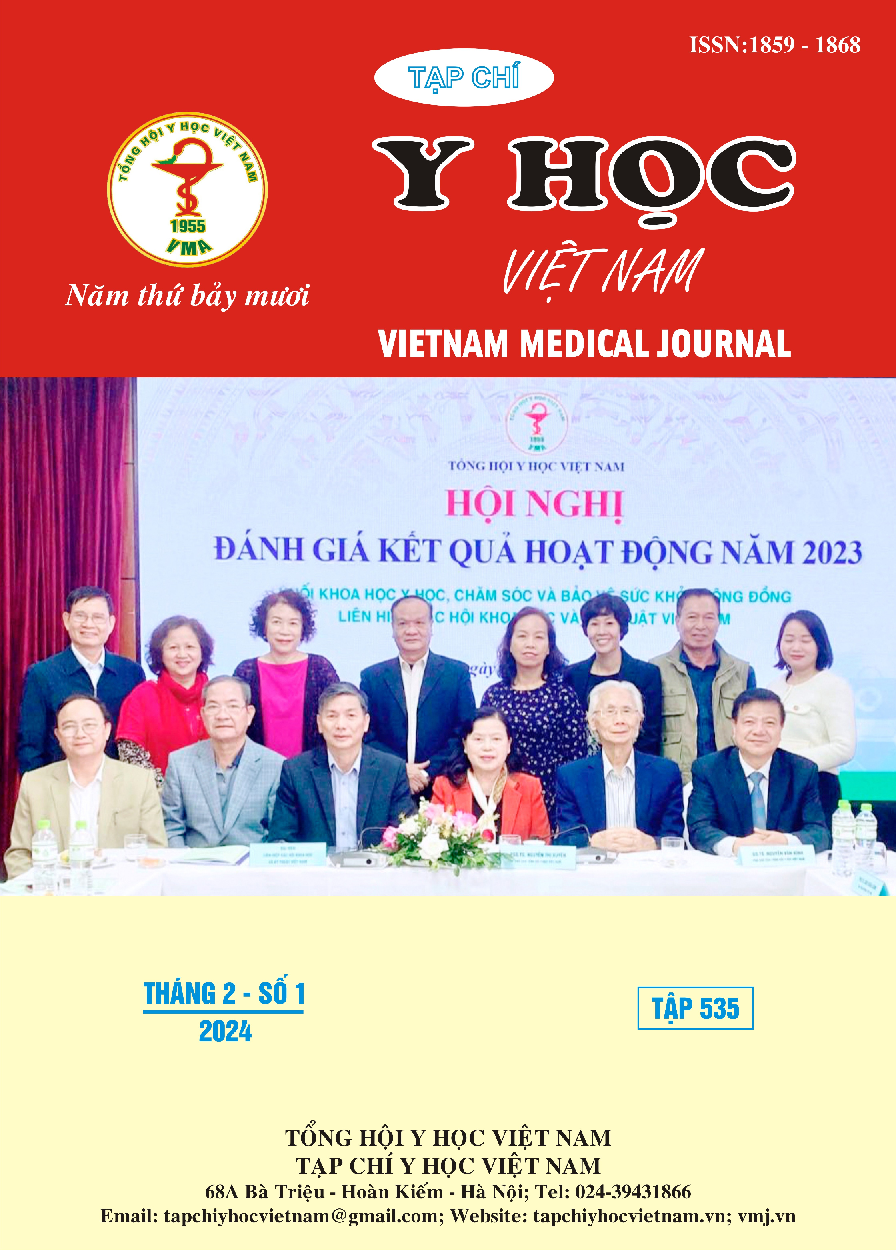THE TRANSCUTANEOUS PCO2, CLINICAL FEATURES AND ARTERIAL BLOOD GASES ON PATIENTS WITH ACUTE EXACERBATION OF CHRONIC OBSTRUCTIVE PULMONARY DISEASE
Main Article Content
Abstract
Objective: To describe some clinical characteristics, arterial blood gases, and transcutaneous PCO2 (PtcCO2) on patients with acute exacerbation of chronic obstructive pulmonary disease (COPD). Method: A case series of 30 patients diagnosed with COPD exacerbation based on the GOLD 2022 criteria. These patients were admitted to the Center for Critical Care Medicine at Bach Mai Hospital from November 2022 to August 2022. The study aimed to evaluate clinical indicators, arterial blood gas parameters, and PtcCO2 values. Results: Among the 30 eligible patients enrolled in the study, aged between 49 and 93 years (mean 70.3 ± 9.7 years), a total of 88 measurements and comparisons were conducted. The main comorbidities observed were hypertension (26.7%), diabetes (20.0%), and heart failure (13.3%). Based on the severity classification of COPD exacerbations, 83.33% of patients experienced severe exacerbations, while 16.67% had moderate exacerbations. The majority of blood gas samples showed increased PaCO2 (72.7%) and decreased PaO2 (44.3%), with an average PaCO2 value of 55.8 ± 13.3. The average PtcCO2 value was 52.6 ± 13.1 (ranging from 30.2 to 82.0). The mean PtcCO2 values for the invasive mechanical ventilation, non-invasive ventilation/high-flow nasal cannula, and oxygen therapy with goggles/mask groups were 54.2 ± 13.0, 51.7 ± 12.9, and 42.6 ± 10.8, respectively. Conclusions: Most patients with COPD exacerbations admitted to the ICU are elderly with multiple comorbidities and severe exacerbations. Increased PaCO2 and decreased PaO2 are common. The group of patients undergoing invasive mechanical ventilation had higher PtcCO2 results compared to the group of patients using other ventilation methods.
Article Details
References
2. Quinnell T.G., Pilsworth S., Shneerson J.M., et al. (2006). Prolonged invasive ventilation following acute ventilatory failure in COPD: weaning results, survival, and the role of noninvasive ventilation. Chest, 129(1), 133–139.
3. Conway A., Tipton E., Liu W.-H., et al. (2019). Accuracy and precision of transcutaneous carbon dioxide monitoring: a systematic review and meta-analysis. Thorax, 74(2), 157–163.
4. Vũ Phi Hùng, & Chu Thị Hạnh (2022). Đặc điểm lâm sàng, cận lâm sàng và nồng độ CRP, NT-proBNP ở người bệnh đợt cấp của bệnh phổi tắc nghẽn mạn tính. Tạp Chí Y học Việt Nam, 518(2).
5. Fruchter O., Carmi U., Ingenito E.P., et al. (2011). Transcutaneous carbon dioxide in severe COPD patients during bronchoscopic lung volume reduction. Respiratory Medicine, 105(4), 602–607.
6. Nguyễn Lân Hiếu, Nguyễn Duy Thắng, & Phan Thu Phương, (2023). Đặc điểm lâm sàng và siêu âm tim ở bệnh nhân đợt cấp bệnh phổi tắc nghẽn mạn tính. Tạp Chí Y học Việt Nam, 529(1).
7. Ongel E.A., Karrakurt Z., SalturkC., et al. (2014). How do COPD comorbidities affect ICU outcomes?. Int J Chron Obstruct Pulmon Dis, 9, 1187-1196.
8. Hà Thị Tuyết Trinh (2015), Nghiên cứu đặc điểm lâm sàng, cận lâm sàng và một số yếu tố nguy cơ của đợt cấp bệnh phổi tắc nghẽn mạn tính tại Bệnh viện Phổi Trung Ương, Luận văn tốt nghiệp bác sỹ chuyên khoa cấp II, Đại học Y Hà Nội
9. Nguyễn Thị Thúy Vinh (2010). Nghiên cúu một số yếu tố chỉ điểm viêm CRP, TNF, IL6 ở bệnh nhân COPD đợt cấp, Luận văn thạc sỹ y học, Trường Đại học Y Hà Nội
10. Hoàng Thủy, Nguyễn Viết Nhung & Nguyễn Đình Tiến (2022). Đặc điểm khí máu động mạch trong đợt cấp của bệnh phổi tắc nghẽn mạn tính. Tạp Chí Y học Việt Nam, 515(2).


